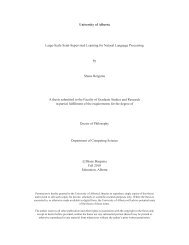The high altitude wildlife areas of western Arunachal Pradesh
The high altitude wildlife areas of western Arunachal Pradesh
The high altitude wildlife areas of western Arunachal Pradesh
You also want an ePaper? Increase the reach of your titles
YUMPU automatically turns print PDFs into web optimized ePapers that Google loves.
Appendix 1<br />
N. goral hodgsoni 25 . N. goral bedfordi is the Western Himalayan sub-species. In effect,<br />
Schedule III <strong>of</strong> the Indian Wildlife Act covers only the Himalayan goral, and the<br />
reference to N. hodgsoni can be deleted from it to avoid confusion. More importantly, we<br />
recommend the immediate inclusion <strong>of</strong> the red goral and the Chinese goral in Schedule I<br />
<strong>of</strong> the Indian Wildlife Act. <strong>The</strong>se are species <strong>of</strong> global conservation concern, and it is<br />
only appropriate that they are accorded the <strong>high</strong>est protection status under Indian law.<br />
<strong>The</strong> addition <strong>of</strong> the Chinese goral to the list <strong>of</strong> large mammals <strong>of</strong> the Indian subcontinent<br />
makes India the only other country apart from China to harbour all three<br />
currently recognized species <strong>of</strong> goral. In fact, the Mago Chu Valley <strong>of</strong> Tawang, along<br />
with adjoining <strong>areas</strong> <strong>of</strong> West Kameng District, is perhaps the only known region in the<br />
world to have all the three goral species. <strong>The</strong> area also has two other goat-antelopes –<br />
takin Budorcas taxicolor and serow N. sumatraensis. Our survey has also established the<br />
occurrence <strong>of</strong> other rare and threatened <strong>wildlife</strong> in this region, such as the snow leopard<br />
Uncia uncia, dhole Cuon alpinus, musk deer Moschus sp., bharal Pseudois nayaur, and<br />
the Himalayan marmot Marmota himalayana (Chapter 2). Most <strong>of</strong> these species are<br />
currently hunted in the area. Establishment <strong>of</strong> community awareness and conservation<br />
programmes, and designation <strong>of</strong> a protected area that is locally appropriate (such as a<br />
conservation or community reserve) are required urgently to safeguard the future <strong>of</strong> this<br />
fascinating <strong>wildlife</strong> assemblage <strong>of</strong> Western <strong>Arunachal</strong> <strong>Pradesh</strong>.<br />
References<br />
1. Pine, R.H. (1994) New mammals not so seldom. Nature, 368, 593.<br />
2. Schaller, G.B. & Vrba, E.S. (1996) Description <strong>of</strong> the giant muntjac (Megamuntiacus<br />
vuquangensis) in Laos. Journal <strong>of</strong> Mammalogy, 77, 675-683.<br />
3. Amato, G., Egan, M.G. & Rabinowitz, A.R. (1999) A new species <strong>of</strong> muntjac, Muntiacus<br />
putaoensis (Artiodactyla, Cervidae) from northern Myanmar. Animal Conservation, 2, 1-7.<br />
4. Giao, P.M., Tuoc, D., Dung, V.V., Wikramanayake, E.D., Amato, G., Arctander, P. &<br />
MacKinnon, J.R. (1998) Description <strong>of</strong> Muntiacus truongsonensis, a new species <strong>of</strong> muntjac<br />
(Artiodactyla: Muntiacidae) from Central Vietnam, and implications for conservation. Animal<br />
Conservation, 1, 61-68.<br />
5. Rabinowitz, A.R., Amato, G. & Khaing, S.T. (1998) <strong>The</strong> discovery <strong>of</strong> the black muntjac,<br />
Muntiacus crinifrons, in northern Myanmar. Mammalia, 62, 105-108.<br />
6. Datta, A., Pansa, J., Madhusudan, M.D. & Mishra, C. (2003) Discovery <strong>of</strong> the leaf deer Muntiacus<br />
putaoensis in <strong>Arunachal</strong> <strong>Pradesh</strong>: an addition to the large mammals <strong>of</strong> India. Current Science, 84,<br />
101-103.<br />
7. Mani, M.S. (1974) Ecology and Biogeography in India. Dr.W.Junk b.v. Publishers, <strong>The</strong> Hague.<br />
8. Rodgers, W.A. & Panwar, H.S. (1988) Planning a <strong>wildlife</strong> protected area network in India<br />
(Volume I & II). A report prepared for the Department <strong>of</strong> Environment, Forests & Wildlife,<br />
Government <strong>of</strong> India. Wildlife Institute <strong>of</strong> India, Dehradun.<br />
9. Myers, N., Mittermeier, R.A., Mittermeier, C.A., da Fonseca, G.A.B. & Kent, J. (2000)<br />
Biodiversity hotspots for conservation priorities. Nature, 403, 853-858.<br />
10. Mittermeier, R.A., Myers, N., Thomsen, J.B., da Fonseca, G.A.B. & Olivieri, S. (1998)<br />
Biodiversity hotspots and major tropical wilderness <strong>areas</strong>: approaches to setting conservation<br />
priorities. Conservation Biology, 12, 516-520.<br />
11. Olson, D.M. & Dinerstein, E. (1998) <strong>The</strong> global 200: a representation approach to conserving the<br />
Earth's most biologically valuable ecoregions. Conservation Biology, 12, 502-515.<br />
12. Katti, M., Singh, P., Manjrekar, N., Sharma, D. & Mukherjee, S. (1992) An ornithological survey<br />
in eastern <strong>Arunachal</strong> <strong>Pradesh</strong>, India. Forktail, 7, 75-89.<br />
32

















